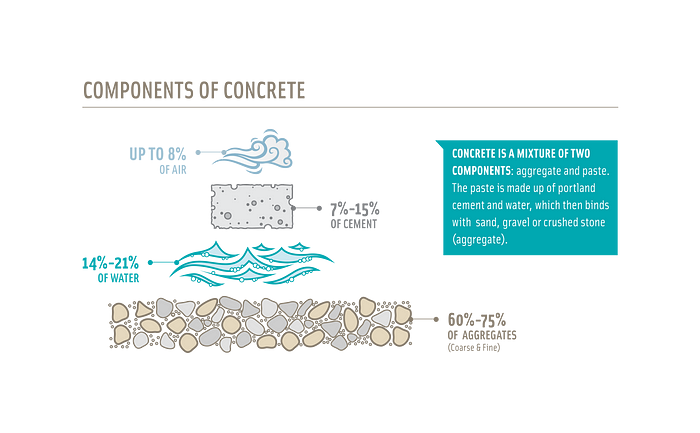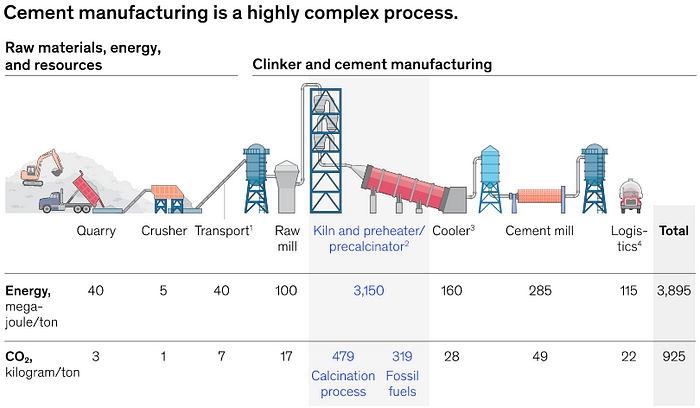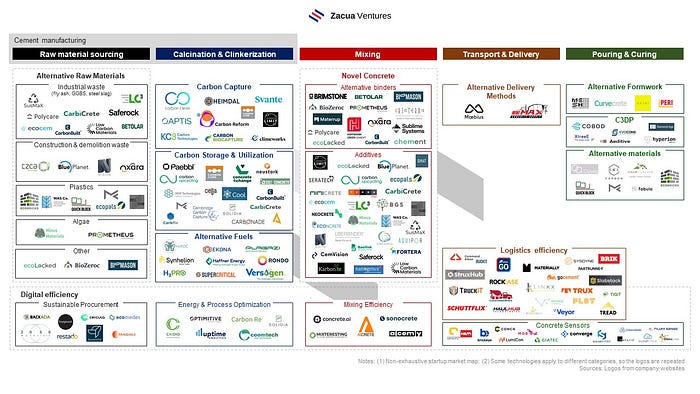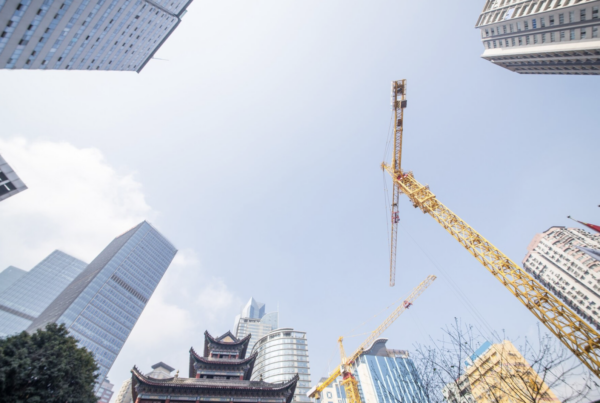Executive Summary:
Did you know that cement production is one of the most crucial industries when it comes to reducing carbon emissions? It is a key driver for climate and global warming, as it is responsible for roughly 8% of total global CO2 emissions.
As the cities continue to grow, so does the demand for cement and concrete. Therefore, finding sustainable ways to produce it is crucial to combat climate change. The roadmap to a greener future relies on cutting-edge technologies to decarbonize cement and concrete production and achieve net zero in 2050.
In this article, we assess the main decarbonization pathways for the cement and concrete industries, and dive into the challenges and tailwinds for their adoption in the coming years.
Why Green Concrete Now:
Climate change has emerged as one of the biggest environmental threats our world is facing. For the first time, both developed and developing countries agreed at the COP21 in Paris to take action and set the goal of limiting the temperature increase to 1.5 degrees Celsius. Meeting this target will not be possible without an ambitious strategy to decarbonize the building sector, particularly, the cement industry that is responsible for approximately 8% of total global CO2 emissions.
Many other regulations and initiatives have been put in place aiming at reducing the greenhouse gas emissions (GHG) of the industry such as the European Union’s Green Deal that has set a goal to reduce greenhouse gas emissions by at least 55% by 2030, and to achieve net-zero emissions by 2050, and the Climate Ambition Statement of the Global Cement and Concrete Association (GCCA) that brought together 40 of the world’s leading cement and concrete companies (accounting for around 40% of global clinker production), signing up for a target of delivering carbon-neutral concrete by 2050.
At Zacua Ventures, we are deeply committed to contributing towards achieving these goals not only by funding innovative solutions making an impact on this decarbonization journey, but more importantly, by allowing them to accelerate and scale up thanks to our network and resources, providing close guidance and support.
The Traditional Concrete Production Process:
Concrete is a crucial building material that is used globally on an enormous scale. In fact, it is the most commonly used construction material in most of the world (particularly outside North America), with around 25 billion tons of concrete produced each year.
People often use the terms “cement” and “concrete” interchangeably; however, they are not the same. Cement is one of the ingredients of concrete, precisely, the glue or binder of the different elements.
Concrete is generally made of 7 to 15% of cement, 15 to 20% of water and 65 to 75% of aggregates such as sand and gravel or crushed stones. Therefore: Cement + Water + Aggregate = Concrete.

Source: Portland Cement Association
Cement comes in different forms, but Portland cement is by far the most used globally to produce concrete, which contains up to 95% clinker and the other 5% being gypsum. The production process of cement is complex and involves the following main steps:
- Raw material sourcing and crushing: the process begins with the extraction of raw materials, primarily limestone that is crushed and ground into a fine powder.
- Calcination & Clinkerization: that powder is heated at extreme temperatures (+ 1,450 degrees Celsius) into a rotary kiln to produce clinker. This step result in the two major sources of CO2 emissions from:
(a) the chemical process of limestone (calcium carbonate) decomposition that releases CO2, when CaCO3 turns into calcium oxide (CaO) and CO2, accounting for 50 to 60% of cement’s CO2 emissions, and
(b) the thermal emissions resulting from the use of fossil fuels to heat the kiln at such high temperatures, making up to 40% of cement’s CO2 emissions. - Cooling and grinding of clinker together with gypsum to produce the final product cement that is then transported and distributed.
Once cement powder is delivered, the concrete is then produced by:
- Mixing the cement with the other components (water and aggregates) to form a homogenous mixture, which is either used in the factory for certain use cases such as precast or bricks, or transported to the construction site by the concrete trucks in the rotating drum.
- Pouring and curing: once in the jobsite, the concrete is poured into the formwork or structure and finally, allowing the concrete to dry and harden until it reaches its full strength and durability.

Source: McKinsey report Laying the foundation for zero-carbon cement
The Challenges of Concrete Production:
Concrete is the world’s most-used building material and is the second-most consumed substance in the world, just after water. Considering its versatility, performance characteristics and broad availability of raw material, it is likely that concrete will remain the construction material of choice across the globe. However, its production process (and precisely that of cement) has remained largely unchanged for decades and given its negative impact on the environment, there is now a pressing need to re-evaluate it. The biggest challenges that the industry needs to overcome are the following:
- Large carbon footprint: for most, the industry needs to solve for the large CO2 emissions of its manufacturing process (accounting for 8% of global CO2 emissions). Even though cement is just a small portion of concrete, it is responsible for 80%-90% of concrete’s emissions, thus, solving for the thermal and chemical emissions in the cement production process is key to tackle this problem. Broadly speaking, for every ton of ordinary Portland cement produced, up to one ton of CO2 is released to the atmosphere.
- Energy intensive process: significant amounts of energy inputs are required mainly to achieve the high temperatures in the kiln to convert the raw materials into clinker. Typically, the energies used are fossil fuels such as coal, oil and natural gas, moving towards greener energy sources such as hydrogen or using alternative materials like biomass or waste.
- Natural resources consumption: concrete requires large quantities of raw materials (mainly limestone, but also clay, shale, gravel…) that are extracted from mines or quarries, which can significantly impact the local ecosystems. Also, large amounts of water (one of the most precious and scarce resources nowadays) are required at several steps of the production, from cooling the cement to mixing the concrete, thus, minimizing the use of these natural resources would also solve the depletion of these valuable materials.
- Waste generation: concrete waste occurs because of overproduction as it is often produced in excess of what is needed for the project to compensate for any construction mistakes, inefficient quality controls or improper handling. Also, concrete is typically disposed of when existing structures are demolished.
- Limited durability: traditional concrete is susceptible to cracking and deterioration faster over time, which entails higher costs on repair and maintenance.
Promising Technologies for a Greener Industry:
As the world’s demand for cement and concrete continues to grow, so do the innovative solutions trying to mitigate the environmental impacts of its production. Important efforts have been and will continue to be made by startups and corporations around the world to solve these challenges.
This market map outlines the current green concrete startups landscape worldwide:

Green Concrete Market Map
Now, we will deeper dive into some of these use cases and technologies and their specific challenges for a successful deployment:
- AMENDMENT OF THE TRADITIONAL CONCRETE’S RECIPE
- Reduction of Clinker Factor (percentage of clinker in cement):
As mentioned above, traditional Portland cement contains up to 95% clinker and 5% of gypsum. Some solutions aim at reducing the clinker proportion in cement with other Supplementary Cementitious Materials (SCM’s), such as fly ash (a by-product of coal combustion), granulated blast furnace slag (GBFS, a by-product of iron and steelmaking), natural pozzolans or other fillers. By reducing the percentage of clinker in cement, these solutions are reducing both the thermal and chemical emissions related to its production, although to a limited extent. The substitution rate of SCMs for clinker is limited generally to up 40% as the strength of concrete decreases with increasing use of SCMs.
The amount of Portland clinker that can be displaced depends on the type of substitute material used and the strength of concrete required for the relevant application as it affects the properties of the final concrete product. While some substitutes have the potential to enhance strength development and durability of concrete, it is important to ensure that the quality and consistency of the output meet the established standards. Another property of traditional concrete is its high resilience to changes in mixing ratios, allowing for an approximate mix that still achieves the desired characteristics. However, the addition of SCMs reduces this tolerance for mistakes in mixing ratios.
This is one of the most proven technologies and has been used already for a long time. In fact, some SCMs were already an attractive option for reducing the cost of cement (e.g., fly ash or furnace slag are often less expensive than Portland cement) before its sustainable benefits were recognized, thus, having already wider recognition and acceptance from consumers and stakeholders. Most plants already have the required infrastructure so the technology could be easily deployed as it does not typically require significant investments in new equipment or significant changes in the current manufacturing process.
However, one critical challenge on the clinker reduction with SCMs is not only the limited availability of these substitutes materials that vary considerably by region, but more importantly, its long-term availability. As steel and energy sectors step up their decarbonization efforts, their availability is expected to reduce, resulting in an increase of the costs. Also, as stated before, cement can’t be fully replaced with SCMs, so its application, although more easily deployable, cannot fully eliminate the abundant CO2 emissions of its production.
Example of startups: Ecolocked, Carbon Limit, Blue Planet, Ecopals, Seratech, Terra CO2, Carbicrete, Ecocem, LC3, BGS, Nanocrete, Neocrete, Minus Materials, WASCo, Econcrete, Susmax, Neolithe, Uberbinder, Arcadia, Aquipor, Fortera, Cemvision, Saferock, Karbonite, Nanogence, Low Carbon Materials
Self-healing concrete: there are other types of concrete that can impact its carbon component, like Ultra-High-Performance Concrete (UHPC) or Self-Healing (Ultra-High-Durability Concrete: UHDC). Self healing is a type of concrete that has the capacity to repair its own cracks and damages autonomously without need of human maintenance, when cracks occur, these materials are activated and fill the cracks, repairing the integrity of the structure and mitigating further cracking.
Self-healing concrete has the potential to significantly extend the lifespan of concrete structures and reduce maintenance costs, thus, also making it a more sustainable option as it reduces the volume of concrete used in the overall built environment. However, as it does not amend the production process nor the ingredients of concrete, it has a smaller potential impact on CO2 removal.
Example of startups: Basilisk, Mimicrete, DMAT
- Alternative Binders:
Willing to remove clinker as binder altogether, some startups are looking for cement-free concrete solutions. These solutions try to mimic the characteristics of Portland cement with different carbon-free materials (e.g., bio-based materials, geopolymers, or alkali-activated cement).
The potential in terms of reduction of the carbon footprint is massive as these solutions could potentially remove both thermal emissions and chemical emissions of cement production (i.e. that are the two major sources of CO2 emissions, making up to c. 90%).
Cement is a low-value product that is consumed in enormous quantities, so the raw inputs need to be reliable, plentiful, and cheap. Therefore, the availability of the raw material of alternative binders is again a critical factor. To be able to displace clinker, the alternative binders need to not only be produced in large amounts to cover the worldwide demand, which is only possible if their raw materials are also available in sufficient volume and quality, but also be competitive in terms of cost as cement is a commoditized material. Nowadays, there is a “green premium” associated with these solutions as these are not yet able to compete in price with traditional Portland cement.
Also, given that these green alternatives are relatively new, compared to Portland cement, they will need to overcome the following challenges for their wide adoption:
- Behavioral patterns: engineers and builders still lack confidence in the performance and long-term durability of these new binders. Changing their behavior will not happen instantly and will need to build awareness and understanding in the properties of these alternatives.
- Standards and regulations: traditional construction and building codes specify the use of materials and mixture proportions for a given application and given the innovation of these solutions, they might not fit within the rather conservative standards. Despite moving towards performance-based standards, this is a costly and lengthy process.
- Capital investment: existing cement plants would need to be adapted to the new processes and supply chains, which would entail a high capital investment. Also, the capital-intensive nature of cement production compared to revenue means that it can take several years to recoup investments in installations, which might make producers reluctant to shift to new approaches that could render their existing assets obsolete or oversized.
Therefore, these technologies have the most potential to reduce CO2 emissions in the concrete industry, however, these efforts will probably pay off several years from now because they require fundamental change in the way concrete has traditionally been manufactured and the regulations around it.
Example of startups: Brimstone, Biozeroc, Chement, Prometheus, Biomason, Criaterra, Materrup, Betolar, Oxara, Polycare, Hoffmann Green, CarbonBuilt, Sublime System
- SWITCHING TO RENEWABLE ENERGIES AND PRODUCTION OPTIMIZATION
Switching from the use of fossil fuels to more sustainable energies could be a solution for 40% of the CO2 emissions resulting mainly from the thermal emissions of cement production.
Coal, oil and natural gas have been the main fuels used historically, but kilns can burn biomass or waste instead, being a potential quick win from a decarbonisation and cost standpoint. However, these should be properly analyzed as, on one side, the broad use of biomass (mainly wood or crops) can be debatable as could be contributing to deforestation (another of the big problems of climate change) and, on the other side, although switching to waste materials would help reduce waste while providing a source of energy, it can be harmful depending on the type of waste burnt.
Other more sustainable alternatives are renewable energy sources such as electricity from wind and solar sources, or hydrogen. Despite the great potential of these energies, their scalability is hindered by the need for high capital investment in the existing infrastructures and the availability of 100% renewable energies, thus significantly increasing the cost of cement nowadays.
Additionally, companies are increasingly deploying new technologies (smart devices and machine learning tools) to be able to track, monitor and optimize the operations of their cement plants. Several changing variables need to be considered during the production process to maximize production: the raw materials used (quality and consistency concerns), the desired mixture (long innovation cycles, variability of outcome) or the operating concerns (CO2 emissions, bottlenecks). In particular, energy optimization tools are generally a plug-and-play solution that does not require significant installation or high capital investment. Using these new technologies can help cement producers better control their processes and even save costs. .
Examples of Alternative Fuels: Hiiroc, Ekona, Plagazi, Synhelion, Haffner Energy, H2Pro, Supercritical, Versogen, Rondo
Examples of Energy & Process Optimization: Caidio, Uptime Analytics, Solidia, Optmitive, Carbon Re, Coomtech
- CARBON CAPTURE, UTILIZATION & STORAGE (CCUS)
CCUS technologies have the potential to address the problem of the chemical process of limestone decomposition by capturing these CO2 emissions directly in cement plants and storing it in underground geological formations or utilizing it for other purposes, such as for curing concrete.
Therefore, carbon capture technologies draw down CO2 concentrations in the atmosphere by capturing such CO2 at the source of emissions, in case of the cement plants, in the kilns before these gasses escape (i.e. potentially removing half of the emissions of the manufacturing process). The application of this technology is not limited to cement manufacturing but can be deployed in several other industries, such as steel or coal. However, to reach commercial scale, the technology needs to be more economically viable as the initial investment is still very high and could even almost double the price of cement.
Once captured, the CO2 can be stored underground or into rocks. Even though the storage reservoirs are large, there would not be enough space at the pace at which it would be using it. Many countries even lack adequate legal and regulatory framework for CO2 storage, which entails a big risk on the long-term liabilities and responsibilities for potential leaks, and lack awareness to the general public, and might find opposition from communities due to safety concerns.
Instead of storing it underground, the captured CO2 could also be used as an input, for example, for curing. Reusing the CO2 coming from the cement production would be contributing to the circular carbon economy. Concrete would become an even larger sink for CO2, without harming its strength or durability. This technology has been mostly adopted for precast concrete as CO2 as a replacement to steam in the curing process to accelerate strength, improve its long-term durability and reduce energy and CO2 emissions. However, this would be adding a step to the process, adding additional cost to the concrete production.
Examples of Carbon Capture startups: Carbon Clean, Carbon Reform, Heimdal, Svante, Qaptis, KC8, MOF technologies, Carbon Biocapture, Carbon Limit
Examples of Carbon Storage & Utilization startups: Climeworks, Carbfix, Cella, Cambridge Carbon Capture, Maa’va, Carbon Cure, Carbicrete, CarbonBuilt, Carbonade, Carbon Upcycling, Concrete 4 change, Solidia, Cool, Neustark, CO2 Concrete, Carbonaide, Paebbl
- DIGITAL EFFICIENCIES
- Sustainable Procurement:
Traditional procurement practices have primarily focused more on the rule that the lowest price wins than on the influence of such materials on the environment of these purchases. However, in recent years, there has been a growing recognition and awareness on the importance of looking at the environmental impact of construction materials.
Digital procurement technologies can leverage the power of collaboration to help promote sustainable specification and procurement practices by connecting buyers with suppliers of sustainable products, providing transparent information and guidance on the properties of these building materials, facilitate the search of sustainable alternatives and build trust between stakeholders. Notwithstanding the benefits, these technologies are not widely adopted yet, and contractors tend to prioritize known and local suppliers, fearing that digital procurement may be less effective or reliable and that it may compromise on the delivery times or quality.
As the construction industry continues to embrace digital technologies and as awareness and understanding of the benefits of new sustainable building materials grows, it is expected that digital procurement methods will become increasingly popular. With increasing pressure from stakeholders to meet sustainability targets, contractors will be motivated to explore new materials. In this context, these solutions for sustainable materials procurement provide an effective solution that offers greater transparency and flexibility compared to traditional procurement methods.
Examples of startups: 2050 Materials, Tangible Materials, First Planit, Restado, Backacia, Cercula, Ecomedes, Structure Pal
- Mixing Efficiency:
Technology has made an incremental advancement through the utilization of Artificial Intelligence-based tools to assist on the new mixing procedures (particularly, to include SCMs or find new mixtures). One of the main difficulties encountered when using SCMs or other alternative binders is achieving a consistent and standardized mixture, especially considering the natural variation in their attributes.
To address this challenge, AI can be used to help maintain the quality and strength of cement or concrete in a much faster and reliable manner. Rather than creating the mix and performing strength tests, the AI uses data gathered from different sources to predict its properties.
Some of the challenges of this technology are the data availability, as they generally require large input data points to learn the patterns, which can be particularly difficult to obtain for new and innovative materials as well as for privacy concerns from companies as it is sensitive data. Also, mix designs involve several variables and it is essential to ensure that the data used to train the model is representative and diverse enough for all variables to avoid bias and have reliable predictions.
Examples of startups: Mixteresting, Alcemy, AIcrete, Concrete AI, Sonocrete
- Concrete Sensors:
Concrete sensors can be embedded in concrete to mainly track its temperature and humidity. By monitoring the real-time site temperature, humidity levels, and strength-gain properties of concrete, not having to wait until the results of the lab tests, this technology can help increase the process efficiency and reduce waste generated, and rework, thus, ultimately contributing to reducing the carbon footprint of the industry.
As the hardware is getting cheaper and the data collected increases by assessing different conditions, environments, and mix designs, analytics will continue to generate better insight and even be able to predict concrete’s behavior over time. The cost, the ease of installation, the reusability of the sensors or the type of data analytics are some of the differentiation factors between the technologies. The sales dynamics of concrete can be a hindrance to the wider adoption of concrete sensors due to the low profit margins of the concrete industry and the fragmentation of players. Concrete is generally sold by volume and the cost per unit is relatively low, making it challenging for manufacturers to justify the additional cost of sensors.
Examples of startups: Giatec, Cloudcycle, Obralink, Brickeye, Hilti, Sensytec, Maturix, Converge, Concrete AI, Lumicon, Filum sense, Concr, Mobbot
- Logistics & Delivery Efficiency:
Delivery or logistics platforms aim to improve the efficiency and productivity of the hauling process in construction projects. These technologies provide a wide range of features designed to help suppliers and buyers connect and arrange transportation more effectively. For these purposes, they try to digitize the quoting process, manage the dispatching process providing real-time on the location of the truck and materials, or replacing the traditional paper tickets with electronic ones.
While these technologies can provide benefits in terms of efficiency, cost savings and productivity, for their mass adoption, they need to overcome several challenges such as data availability (as they rely heavily on accurate and updated data regarding truck availability, traffic, schedules…), integration with existing (legacy) systems, and appropriate coordination and communication among different stakeholders.
Examples of startups: Brik, Cemex Go, Concrete Direct, GoCement, HaulHub, Materially, MiniMax concrete, Linkx, Moebius, Partrunner, Rockease, RuckIt (Command Alkon), Veyor, ProperGate, Schüttflix, StruxHub, TruckIT, Sysdyne, PLOT, Slabstack, TiQit, Tread, Voyage Control
What we Envisage Moving Forward:
It is time for a change in the cement and concrete industry towards lower-carbon materials to create a cleaner building environment and reach the ambitious global climate goals. While the challenges ahead are considerable, the scale of opportunity is also enormous, which is driving significant startup activity and VC interest.
In this article, we have analyzed the opportunities as well as the challenges of the main technologies that can make the decarbonisation of the industry possible. We believe that no single solution will succeed in solving all challenges, but that disruption will require a careful balance between incremental solutions, through more easily deployable methods leveraging existing technologies and infrastructures (e.g., digital tools or increased use of SCMs), and more transformative solutions, through forward-thinking and disruptive approaches (e.g., alternative binders or alternative materials). Clinker reduction solutions are cheaper and can be implemented more easily, while other solutions like CO2-curing or alternative binders will need more time to continue to mature. Therefore, a combination of all these efforts is necessary to achieve the net-zero goals by 2050, despite safety and structural performance continuing to be critical factors.
Also, regional nuances should be considered when determining the most suitable solutions given the variations in the construction standards, the raw materials availability, climate, or other major pain points and needs in the relevant region.
Speeding up this path will require the efforts and collaboration of all stakeholders in the ecosystem, particularly:
- Suppliers and manufacturers — investing in R&D to improve the environmental performance of their products and adopting more sustainable processes;
- Builders and contractors — prioritizing more sustainable materials with lower carbon footprint in their projects designs and construction contracts, as well as incorporating sustainable practices and awareness of new processes into their operations. The lack of education around these new materials and is hindering its potential further adoption;
- Owners — promoting and asking for greener solutions, choosing to purchase or rent properties that incorporate sustainable building materials (not just based on price);
- Governments and policy makers — implementing policies and regulations that incentivise or even force the use of low-carbon materials at all levels, municipal, city, state, and country levels. Also, moving towards performance-based standards, rather than chemical composition of concrete mixtures, would help some of these new materials meet the required standards. Governments, as major customers of concrete for public projects, should prioritize suppliers with lower embodied carbon, leading the industry by example.
As an active investor, Zacua Ventures will continue to look for the emerging solutions in the green concrete space, searching for the right technologies and startups to be supported in their journey.









